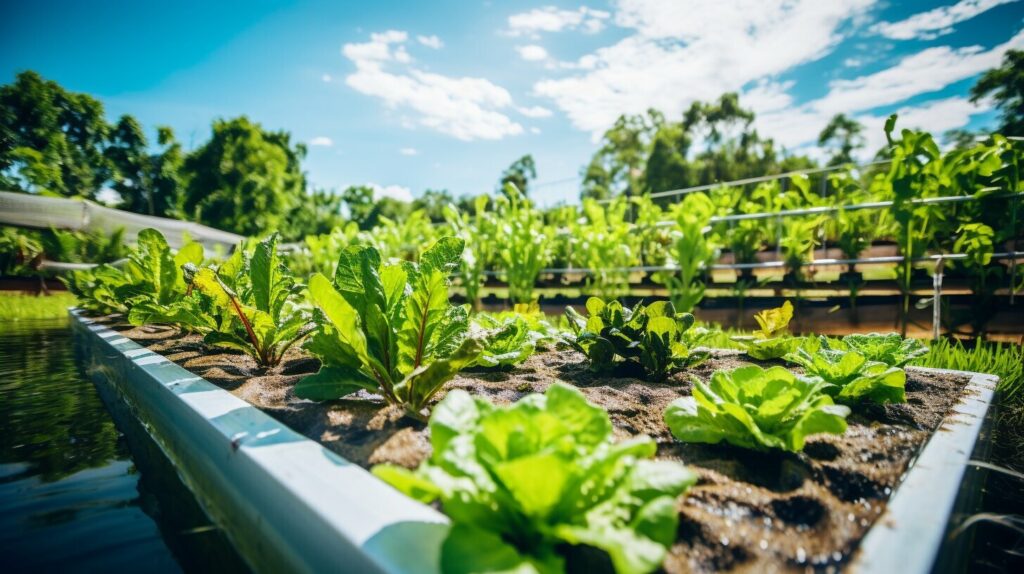This post may contain affiliate links and we may earn a small commission when you click on the links at no additional cost to you. As an Amazon Affiliate, we earn from qualifying purchases. You can read our full disclaimer here.
Aquaponics has been gaining popularity among hobbyists and commercial growers as an innovative and sustainable approach to raising fish and vegetables in a symbiotic system. This cyclic aquaculture method utilizes natural bacterial processes to convert fish waste into plant nutrients, allowing fish and plants to thrive in an integrated and efficient ecosystem.
Effective fish selections establishes successful aquaponic systems. The types of fish greatly influence the water quality parameters, feeding habits, growth rates, and overall productivity of the system. Selecting fish unsuitable for the aquaponic environment or incompatible with the plant species can lead to an imbalanced ecosystem, poor harvests, and system failures.
This blog post will provide a comprehensive guide to the key criteria that aquaponics practitioners should consider when selecting fish species for their systems. Water temperature preferences, growth rate, tank size needs, feeding habits, and plant compatibility will be discussed in detail. The goal is to help readers understand how to evaluate fish species options and choose the best ones to create a flourishing, symbiotic aquaponic ecosystem tailored to their climate and setup specifications.
The information provided in this article will equip aquaponics enthusiasts with the knowledge to make informed fish selections that will optimize the health, productivity, and sustainability of their integrated fish-plant systems.
Understanding Aquaponic Ecosystems
Aquaponics relies on the symbiotic relationship between fish and plants to create a productive, closed-loop system. The fish waste provides a natural source of nutrients for the plants, while the plants help filter and clean the water for recycling back to the fish tanks. This balanced ecosystem requires carefully selecting fish and plant species that can thrive together.
The fish component provides nutrition for plant growth through ammonia from fish waste and uneaten food. Friendly bacteria living in the system convert the ammonia into nitrites, then into nitrates used by plants as key nutrients. The plants absorb and assimilate these compounds, filtering the water so it can return clean and safe for the fish.
Choosing fish with appropriate waste output levels relative to the size of your plant beds is crucial to maintaining this nutritional balance. Species that produce too little waste cannot provide sufficient nutrients, while too much waste accumulation from overcrowded or large fish tanks can be toxic. Moderately productive fish species are ideal for homemade backyard aquaponics systems. Larger commercial systems may accommodate more prolific fish due to higher plant volumes.
In addition, the fish species must be adapted to the system’s water temperature, which is influenced by ambient conditions, climate control methods, and plant choices. Tropical vegetation requires warm-water fish species, while temperate zone plants pair better with cooler-water species. This biological synergy is essential between the fish and plants to optimize growth, health, and yields in an aquaponic ecosystem.
Water Temperature Requirements
One of the most important criteria for selecting fish species for aquaponics is the ideal water temperature range in which they thrive. Fish can be categorized as cold or warmwater species based on their temperature preferences.
Coldwater fish like trout and salmon do best in water temperatures between 50-60°F, while warmwater species like tilapia and koi prefer temperatures from 70-85°F. Tropical fish like gourami and guppies require even warmer water in the 75-82°F range.
When choosing fish, it is critical to match their temperature requirements to the climate where the system is located and the level of temperature control available. Aquaponics practitioners in temperate regions with unheated systems would be limited to hardy coldwater species that survive winter temperatures.
Those with climate-controlled greenhouses can accommodate warm water or even tropical species year-round. Daily and seasonal temperature fluctuations must also be considered to avoid stressing the fish. In case of electrical outages, backup power for tanks with heaters is advisable in colder climates.
Ensuring the water temperature stays within the optimal range for the selected fish species is vital for their health and growth. The grown plants also have temperature requirements that should align with the fish for an integrated system. Careful selection of appropriate water, warm water, or tropical fish based on climate and available temperature controls is key to a thriving aquaponic ecosystem.
Growth Rate and Harvestability
The growth rate of fish species is another key consideration for aquaponics systems. Faster-growing fish reach harvest size sooner, providing a quicker turnover and productivity boost. However, the specific growth rate must align well with the cultivated plants to maintain balance in the ecosystem.
Herbaceous plants like lettuce can be grown on a 3-4 week cycle, so fast-growing fish like tilapia that can reach harvest size within six months are a good match. Fruiting crops may take 3-6 months to mature, pairing better with fish reaching harvest weight in 9-12 months, like Australian Red Claw crayfish.
Slower-growing fish become very large if left to maximum size, requiring more tank space. Large fish like mature koi can also consume plants if housed together in a backyard-sized aquaponics system. In these cases, they are best harvested at a younger age to keep the ecosystem balanced.
The harvest method for the fish species also needs consideration. Trout and other delicate-skinned fish require nets to minimize damage at harvest. Scaleless catfish can be grabbed and removed by hand with less stress. Planning the timing and process of fish harvesting along with the plant growing cycles helps maximize productivity.
Selecting fish with an appropriate growth curve for the chosen plants allows aquaponic farmers to maintain a well-timed production cycle, harvest, and replenish the system. This rotational balance is key for an efficient and prosperous aquaponic ecosystem.
Diet and Feeding Habits

Fish species’ dietary needs and feeding habits also require evaluation when selecting fish for aquaponics systems. Fish can be broadly classified as herbivorous, omnivorous, or carnivorous.
Herbivorous fish like tilapia can subsist largely on plant-based feeds. This helps reduce input costs for aquaponic farmers as these fish can be fed algae or vegetation grown within the system.
Omnivorous fish such as perch and catfish consume both plant and animal matter. They require a balanced feed formula with appropriate protein levels to complement the plant nutrients in the system.
Carnivorous fish like trout predominantly require high-protein commercial feeds to meet their nutritional needs. This can increase ongoing feed costs for aquaponic producers.
The quantity and type of feed input relative to the fish waste output must be balanced based on the system’s plant species, growth stages, and nutritional needs. Overfeeding increases solids loading, which the plants and bacteria must filter. Insufficient feed suppresses fish growth and diminishes the nutrient supply.
Selecting the right combinations of fish and plants based on feeding habits and nutritional needs helps maintain equilibrium in the aquaponic ecosystem for optimal growth and productivity.
Space and Tank Size Requirements
The size of the fish-rearing tanks relative to the volume of grow beds is a key consideration when selecting fish species for aquaponics systems. Each fish species requires adequate room to grow based on their maximum adult size and stocking density.
Small fish like guppies can be stocked densely at up to 100 per cubic foot of tank volume. Larger fish require much lower density – tilapia around one fish per 3-5 gallons of water and full-grown koi at 100 gallons per fish.
The fish tank volume must be balanced with the plant bed area. Not enough fish waste relative to the plant volume leads to deficiencies. However, overcrowded tanks cause toxic ammonia spikes from excess waste.
As a rule of thumb, recommended stocking densities are 1-2 lbs of fish per 10 sq ft of plant grow bed area for hobby systems. The ratios can be increased in larger commercial aquaponics, assuming adequate biofiltration.
Aquaponic system designers must calculate the projected full adult size and stocking density needs for the fish species chosen and scale the tanks and plant beds accordingly. Larger fish typically require longer grow-out durations as well.
Ensuring adequate space and tank volumes to accommodate the selected fish species’ size needs, stocking densities, and production timelines is imperative to maintain a healthy, thriving aquaponic ecosystem.
Conclusion: Effective Fish Selections
Selecting the right fish species is one of the most important decisions in designing and maintaining a successful aquaponics system. Choosing fish well-adapted to the water temperature, tank size, nutrition levels, and other environmental conditions enables healthy growth and waste output to nourish the plants.
Fish must be stocked at the appropriate densities to avoid overcrowding stress and water quality imbalances from excess waste accumulation. Their growth rates and production timelines must align with the cultivated plant varieties for symbiotic harmony.
By considering the key criteria covered in this article, such as temperature requirements, growth rates, diet, and space needs, aquaponics farmers can make informed fish selections tailored to their systems. This will help optimize productivity through a balanced symbiosis between the fish and plants.
With a thriving, bio-integrated aquaponic ecosystem, practitioners can enjoy bountiful harvests of fish and plants in a sustainable and ecologically friendly production method. The information presented here aims to guide in choosing the right fish to serve as the living engine powering that productive ecosystem.



